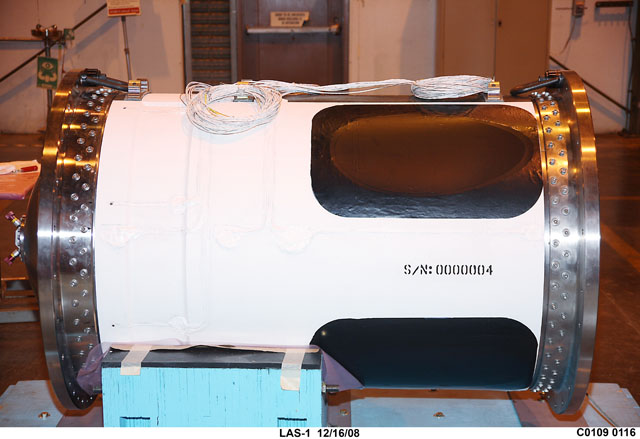NASA is one step closer to launching a flight test of the Constellation Program with Tuesday’s send-off of the Orion jettison motor, a solid rocket motor engineered for the launch abort system of the next-generation spacecraft Orion.
Built for NASA by Aerojet, the jettison motor was shipped from Sacramento, Calif. to the U.S. Army’s White Sands Missile Range in New Mexico for the first test of the launch abort system, called Pad Abort-1. Orion’s abort system will be capable of pulling the crew module away from the Ares 1 crew launch vehicle within milliseconds in the event of an emergency on the pad or during the initial ascent phase.

The jettison motor, a key component of the launch abort system, is designed to separate the spacecraft’s abort system from the crew module after it is no longer needed during launch. A jettison motor function will be needed on every Orion mission.
“The delivery of the jettison motor is a significant milestone for the launch abort system program,” said Kevin Rivers, Orion launch abort system manager at NASA’s Langley Research Center in Hampton, Va. “Delivering this rocket motor is a great reflection of the intense and focused work by the entire jettison motor team.”
The NASA Orion Project is managed out of NASA’s Johnson Space Center, Houston. NASA’s Langley Research Center in Hampton, Va. manages the Orion Launch Abort System element development and integration in partnership with NASA’s Marshall Space Flight Center in Huntsville, Ala.
The components of the abort system are being delivered by Orbital Sciences Corporation, for Lockheed Martin Corporation, the prime contractor for Orion. Aerojet is the subcontractor responsible for the jettison motor.

Any news on when PA-1 is currently targeted. The last published date I could find stated April 2009, but that obviously is not the case 🙂
Thanks
I THANK THE DIVERSE AND HIGHLY SKILLED NASA TEAM BRINGING FORTH A NEW GENERATION OF FLIGHT VEHICLES. HEAVY LIFT AND SPACE PLANE TECH NEEDS FULL FUNDING. WE RECEIVE A WORLD OF SCIENCE AND MATERIAL TECHNOLOGY WITH EVERY DOLLAR INVESTED IN NASA. A BRIDGE TO THE NEW FRONTIERS OF SPACE CAN NOT BE A MINOR EXPENDITURE.
How do we make sure that the launch abort system improves crew safety? Given the violence of the launch and ascent environment, I have to imagine that a launch abort is a risky proposition. How do you prevent a false actuation of the abort system while still achieving a milliseconds response time after a failure? Talk about “Extreme Programming!” Whew!
Pete, I think a launch abort is risky, but much safer than *not* aborting when you need to! The answer to making it as safe as possible is testing, testing, and more testing, and redundancy.
The US has never had a launch abort (some engine shutdowns while still on the pad on Gemini 6 and a few shuttle flights, and one shuttle flight had an abort to orbit, which happens when an engine shuts down late enough into the launch that they can still reach orbit on the remaining engines, but these don’t count as tests of an LAS.) The only US flight where a launch abort system could have been used if available was the Challenger, but of course the shuttle doesn’t have an LAS, and wasn’t designed for one. (There may have also been some early unmanned Mercury launches where its LAS was put to the test unintentionally, but not on any manned flights.)
However the Russians have had two Soyuz launch aborts, using a very similar system to Orion’s, and it worked fine both time. Also, in addition to deliberate LAS tests, the Russian moon rocket, which exploded on the pad or early in flight in all its test flights, carried a Soyuz capsule (maybe a dummy or boiler plate, rather than a real capsule), but at least some of them had live launch abort systems, and in all those cases, it worked properly and if people had been on board, they would have survived. I read this in a Wikipedia article, but have no reason to suspect it’s accuracy.